A Paper Delivered at a meeting of American Society for Eighteenth Century Studies conference in Cleveland, Ohio
Renaissance Hotel, Cleveland, Ohio, April 4th-6th, 2013. Panel: 18th century and Film. Chair: Professor John O'Neil. Other Panelists: Daniel Brewer, “Screening the Anachronic Sade;” Moti Gharib Shojania, “Kubrick and Kant: Reframing the Enlightenment in Stanley Kubrick's Barry LyndonDiasporic Jane: images of displacement, exile and homelessness in the Austen films
In From Prada to Nada, upon meeting Bruno (the Brandon character), Mary (the Marianne) asks, “Are you homeless?”, he replies: “No, are you?”
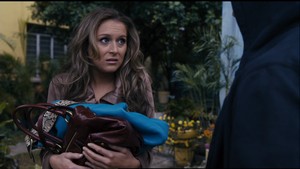
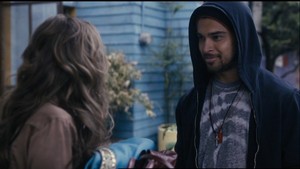
It may not surprise readers to be told that Jane Austen's Sense and Sensibility films display an excess of images of displacement, exile, and homelessness. But Pride and Prejudice, Mansfield Park, Persuasion, Northanger Abbey, even Emma filmed also have much dislocation, harrowed lostness, and forced travel. In their “Appropriating Austen: Localism on the Global Scene,” Greenfield and Troost suggest heritage adaptations are replaced because they don't address their audience's real concerns; once the heroine with no career outside marriage and Austen's scepticism towards family and social life are removed, Austen appropriations have a sustaining glocal appeal.1 By contrast, I show important elements in Austen's books, including alienated social identities, de-housed heroines, geographic displacement, resulting epistolarity, and quests for refuge appear as often in heritage as appropriation films.
Jane Austen's Sense and Sensibility is especially a book where gender and impoverishment are the basis of exile, a continuum of displacements and identity seeking, of unexpected unwanted intrusions, which add up to “a psychosocial condition” that dramatized generate a “poetics” of longing and distress as in this evocative nadir of Dashwoods' departure to Cleveland. A clip from“I do declare I have never disliked a person so much,” to “a moment's peace” (see S&S Screenplay. 172-74, the music is "Leaving London").
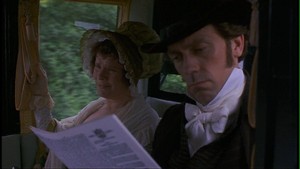
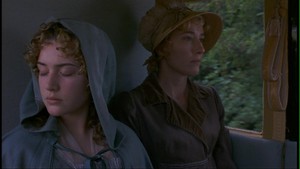
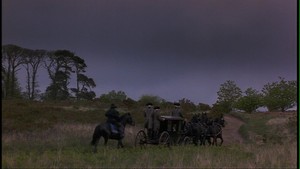
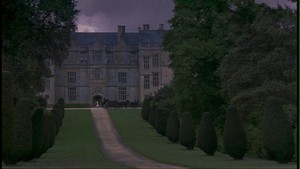
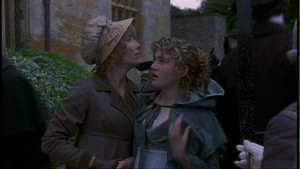
I reverse the way film studies usually proceed and begin with the S&S films and the Austen film canon rather than their novels because the films also emerge from other sources and make visible how Austen's women internalize “a diasporic state of existence” (Amin, 153, 155). I discuss Austen's writing next and return to scenes in the S&S films dependent on Austen's text and transformed scenes from Emma and S&S to argue that Austen's novels are in Austen films used to dramatize a process of intense resistance to falsifying identities (Hudelet 148). 2
The most frequent image in the S&S films is the journey, ejection from a home, and exile and discomfort in an estranging space. Two of four repeating paratexts in the 1971 S&S are of journeys: the first shows them winding round and out of their home place:
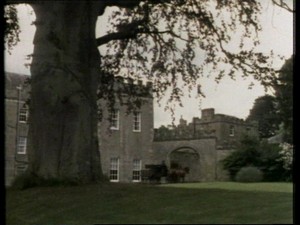
Three long tedious cough-producing, wandering journeys are presented in both the 1971:
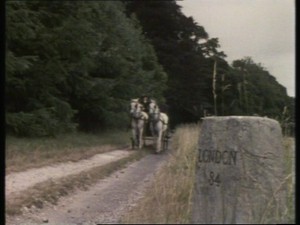
and 1981 films. In the latter the women are literally sickened:
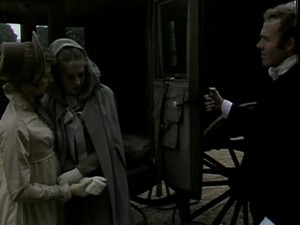
there's Marianne stumbling out of a crowded coach into a narrow space; their conversations project internalized harrowing:
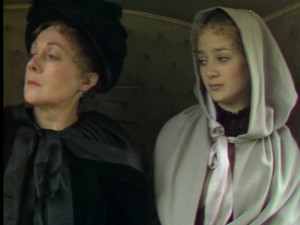
House-hunting, Mrs Dashwood's near 1st remark in the film about her sister-in-law, Fanny Dashwood sets the note: “Upon my life I do not know a more unpleasant woman.”
The landscape in Davies's 2008 S&S is exhilarating, strangely beautiful: we glimpse Stonehenge:
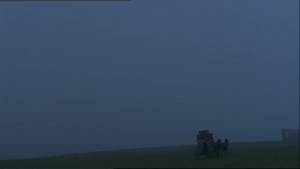
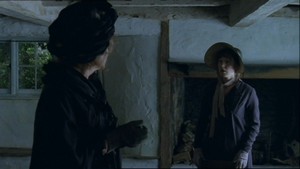
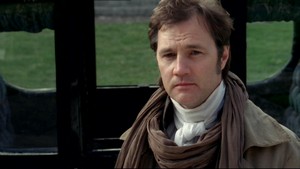
is there watching while “little Mr Palmer” is made much of, we are reminded that Eliza's, his, and Willoughby's baby (whom we've just seen), but for Brandon would be homeless.
Journeying in the S&S appropriations is also troubling and vexatious, a result of a drop in status. The Tamil I Have Found It overflows with people on the move in trains, buses, trucks, on bikes, but for women these experiences are disheartening. Our heroines take but two journeys: by train from their palatial village residence to a rented apartment from which they are at first threatened with eviction for non-payment of rent; by moving van when Sowmya (the Elinor character) is promoted from receptionist (hard-fought for) to computer programmer and can take out a mortgage on a large apartment. Early on Padme (the mother) sells her jewels
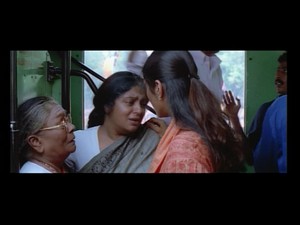
to pay that rent
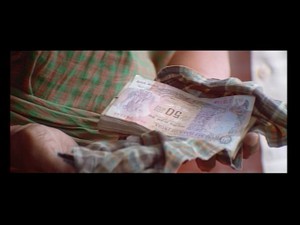
and Sowmya is repeatedly rejected at interviews
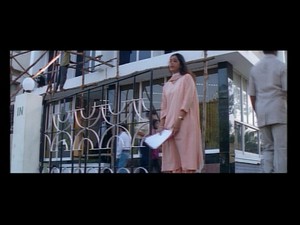
but a providential pattern is overt, for example, pushed into a corner of a bus seat
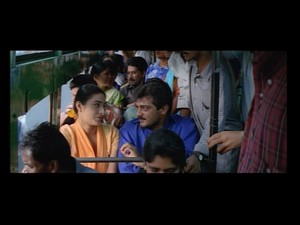
Sowmya and Manohar (our Edward) still can talk privately. Once the family controls their space, their home is presented as a place they are safe from intrusions in.
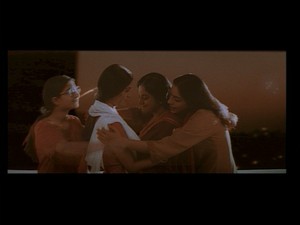
Amid fireworks, they celebrate: Padme says she doesn't feel “like we've moved to a new house. It feels as if we've lived here for ages,” and Sowmya replies: “No one can drive us from here.”
The sisters in From Prada to Nada take one brief journey West to East LA; that's all that's needed to make the stunning visual point that two utterly disparate worlds exist on either side of
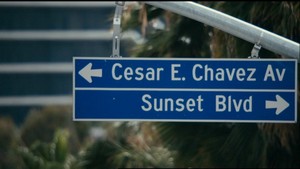
a sign. The way to East LA includes jeering intrusive stares and remarks from men in a nearby vehicle, belligerent street prostitutes:
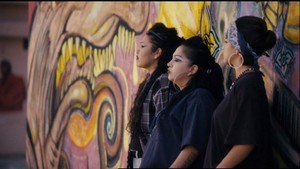
and a near accident. When Mary and Nora (our Elinor) reach the boarding house of their long-estranged aunt, they find Spanish, which they do not know very well, is spoken. Illegal women immigrants are there & sewing all day. Once there the sisters walk; Nora takes a bus to the other side of town where middle-class jobs are located:
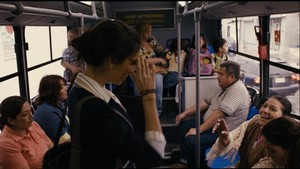
she is startled and uncomfortable; people may be friendly but she must learn to speak Spanish. Mary is forced to give up her expensive car; to get to college, also on the other side of town, her aunt lends her an old car that works poorly. In a mixed borrowing from Lee and Davies's S&S films and I have Found It, when Mary flees the crucial party after the wealthy teacher's assistant Roderigo (our Willoughby), with whom she has spent a night in bed, turns out to have a rich wife, Mary must use this car in the pouring rain. Unable to cope, she crashes it, ending up in hospital. She is brought back to what is now home in a wheelchair in a public bus
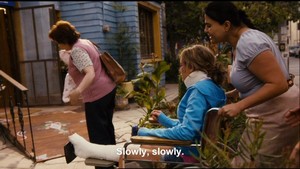
Nora and Edward conduct their major successful courting scenes by a moving van
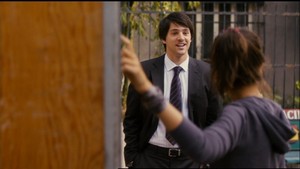
A quick survey of the canon, heritage to appropriation, 1970s to today: 1979 Elizabeth home from Hunsford
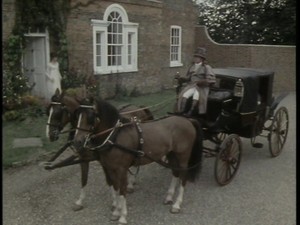
is dismayed to find home is not this unchangeable haven she thought it was:
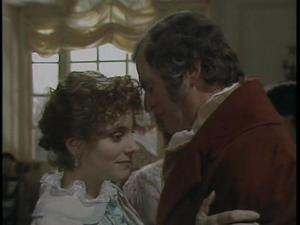
Bingley's leaving Jane is visualized in Bride & Prejudice by a heavy-laden car:
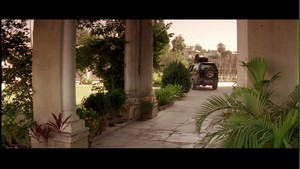
driving off, and then a train in a desolate landscape:
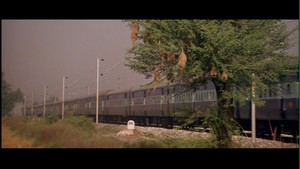
1999 Fanny Price at 10, not at all prepossessing:
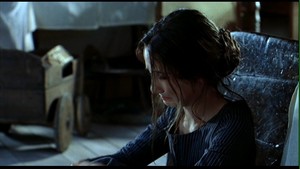
grieves in the attic. Several Austen appropriations begin with the heroine driving a car fast: Ruby in Paradise (a Northanger Abbey film) differs because Ruby's speed:
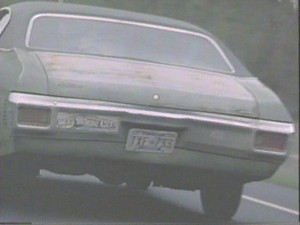
has a solid motivation: her John Thorpe wants her back:
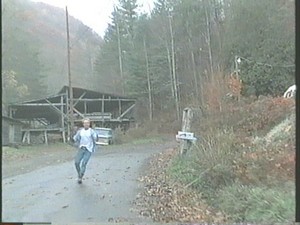
later she says to have escaped the way she did, not pregnant and not beaten, was lucky. 1995: Anne Elliot leaving Kellynch does so in humble awkward cart with animals
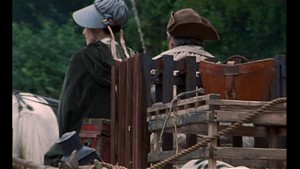
2007: Anne Elliot on the beach:
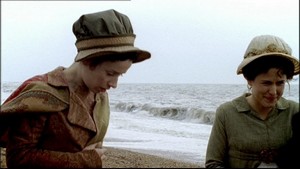
recalls the heroine of Chadha's Bhaji on the Beach:
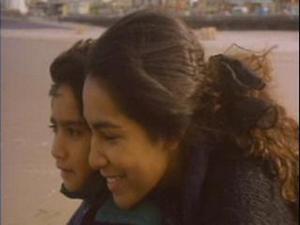
Chadha made Bride &Prejudice.
Two trajectories of thought and feeling come together in these films. The first, from Austen's writing, which for some films include the juvenilia, letters and criticism, derive from Austen's anxieties as a dependent vulnerable woman. Ubiquitous in the novels is the insistent awareness that young women are excluded from independence and power, from an income, except if they marry or (a rarity) are heiresses. In Emma Jane Fairfax describes the work of a governess in terms that make Mrs Elton think Jane is referring to the slave trade (E 2:17, ch 35:223). All 4 heritage Emma films have a version of this dialogue
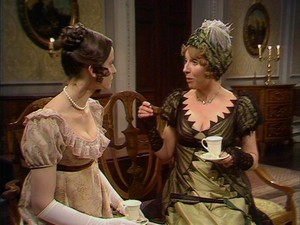
1972 Mrs Elton cannot brush Jane Fairfax's Jane Eyre-like burning intensity off. Emma Watson says, “teaching in a school” is far worse (The Watsons, MW 318), and all the novels make desolating the husband-hunt for money and “marrying a man” one does not really like: “do anything rather than marry without affection” cries Jane Bennet (P&P 3:373). Yet, as Mr Knightley tells Emma, most men “do not make imprudent matches” (E 1:66). The kernel story of Sense and Sensibility, her chosen first novel is a discreet variation on how she felt ejected from her home in Steventon. Austen did not have a place with stability and liberty enough for her to write for publication for 9 years – or until after a sister-in-law died, and a brother, Edward, offered Chawton I had almost said Barton cottage on his estate to live in. It's been suggested the way in the last published novel, Emma, the long-time governess, poor Miss Taylor's delayed marriage is described comes closest to capturing the best a woman like Austen could then hope for (Goubert 354-55).
In the letters Austen seems never to forget that marriage brings continuous pregnancy and children. In these Austen says of her niece “poor” Anna once again pregnant after a miscarriage, and two live births inside 4 years of marriage, “she has not a chance of escape; her husband called here the other day, & said she was pretty well but not equal to "so long a walk; she must come in her "Donkey Carriage."--Poor Animal, she will be worn out before she is thirty” (JA Letters, 155, 23 Sun 1817, 351). The remnant we have from the time of Austen's father's decision to leave Steventon show Jane experiencing how her family members were indifferent to her things precious to her identity (e.g., her books, the piano). In her life in Bath, Southampton, Chawton Austen spends much of her time with single dependent women: a close friend, a paid companion, Martha Lloyd; governesses (Miss Anne Sharp, Miss Crewes), servants high and low (from Madame Bigeon to Eliza), women in hovels at risk of homelessness, most notably Miss Benn, a source for Miss Bates. Miss Austen Regrets gets it right to make Jane's understanding friend Madame Bigeon:
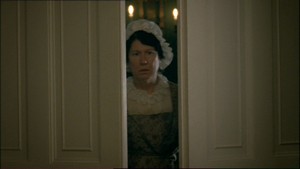
In 1808 Austen had a scheme of life for herself, Cassandra, and Martha apart from the rest of the family which she proposes to Cassandra more than once; it gets nowhere. 1814 the height of her earning power, traveling anywhere is dictated by others' needs. In her letters Austen voices Woolf's, Pateman's, post-colonial insights that women are subject and subaltern people.
The second trajectory is a 20th to 21st century contemporary anxiety thought to account for the popularity of heritage films. We need not go to Downton Abbey but look at one of Davies' images of an alluring strong Barton Park:
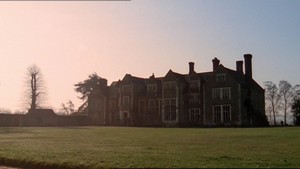
It's argued a post-modern perception of life has led to the pervasive idea that our identity comes from a repository of memories which need not have any concrete correlation (Ghosh and Sarker 103, 105; Brubaker 1-5 ). But globalized mass and group emigrations, imperialist departures of males to wrest wealth from lands and other people, and victim diasporas go back well before the eighteenth century (Bailyn, Olson; Hodson). Austen saw this in Charles and his family's peripetatic life:
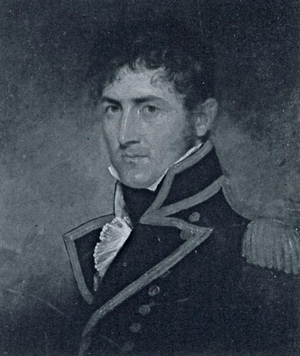
in Francis whom she romanticizes as Captain Wentworth
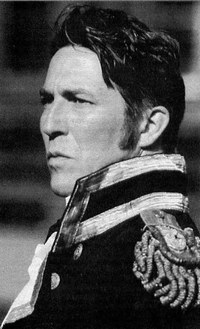
in Persuasion, at its close still at risk of drowning. Austen's Sense and Sensibility, Mansfield Park and Persuasion show most people's identities are not in their power, but a function of where they are placed.
We now look at a scene which recurs in 5 of the 6 S&S films, and which are fairly close to Austen's text.3 After Edward has been disinherited by his mother, Elinor tells him that Colonel Brandon has offered him a living as a clergyman (S&S, 3:4, 243-46). The 1971 S&S uses Nancy's statement to Elinor that a broke Edward had fled to a country inn for three days after his mother ejected him from the house (S&S, 3:2, 230) to have it unfold outside genteel life. We see Elinor slowly mounting worn stairs
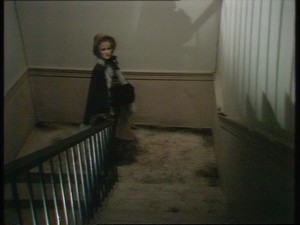
Edward sitting reading
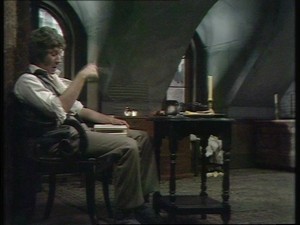
Using Austen's words, the scene is confrontational
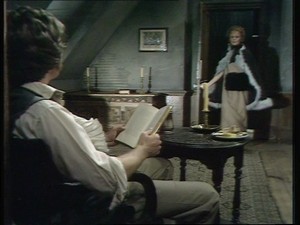
Edward fails to break down Elinor's facade of self-control; they clash in a kind of mutual fierce futility. In 1981 in a dark upstairs room in Mrs Jennings's London house, again using Austen's words, a quietly distraught Edward looks at himself in a mirror
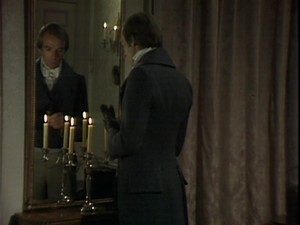
and tells Elinor, this is “the saving of him” in a way that calls to mind the line in Austen's book attributed to Lucy that after this solution to his difficulties “she had never seen him in such spirits in her life.” Ang Lee, Emma Thompson and Hugh Grant (as Edward) give us a comedy of erotic thwarting and embarrassment:
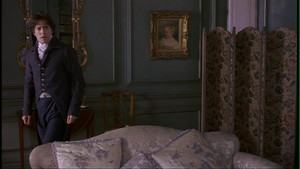
ending on desolation:
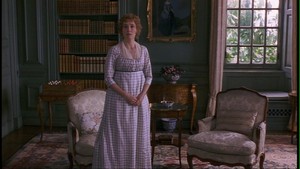
Davies's half-minute silhouette version:
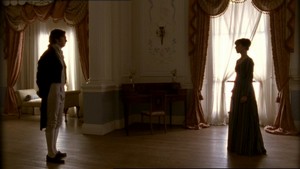
has Edward asking: “Why do you not think badly of me?,” to which Hattie Morahan as Elinor, concisely plangent, replies: “You have never deceived me.” In I Have Found It, sitting at a lunch counter in a bare cafeteria, Manohar reacts firmly against Sowmya's prudent advice:
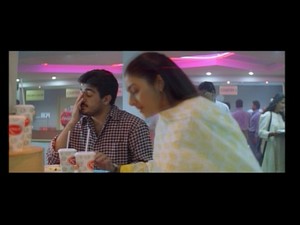
to take the parents' renewed offer of a job as an engineer; “So now I'm not practical. I'm just a dreamer, is that it? … I'm a failure, okay.” He tells her to get herself “a green card,” go to the US and “marry somebody else.”4
Transformed scenes from Emma, in heritage and appropriation films alike, produce striking scenes that feel unpredictable, yet remain recognizable and become influential. The heritage 2009 Emma from Austen's text shows us the back story of Emma is one of the removal of young children from their parents: Mrs Churchill coldly takes Frank:
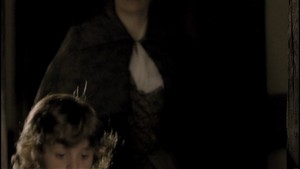
a frightened Jane:
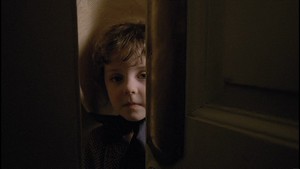
is given up by Miss Bates:
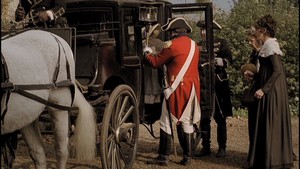
All the scriptwriters of Emma but McGrath pick up on the irresponsible indifference of Emma to Harriet Smith, the vulnerable girl she has supposedly befriended and how Emma's gossip is a real threat to Jane Fairfax's reputation too. To go beyond the fecund Clueless, in the recent Delhi film, Aisha, a super-rich irresponsible Emma concocts a tryst for the innocent middle class Shefali (a cross between Harriet and Jane) and Randhir Ghambir, Mr Elton as the ambitious son of a wealthy grocer: Aisha lies about a restaurant all three should go to, drives them to a risque place in the city, whereupon she and her car vanish. The couple find themselves treated as adults seeking to have illicit sex in a motel; stranded in a dangerous part of Delhi that might as well be another country, they set out on a long night walk:
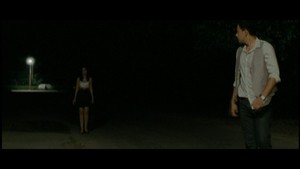
that shows us Shefali, in her short-skirted sexy outfit, tottering along in high-heels. Aisha's mortifying later apology in feel harks back to Stillman's 1998 Last Days of Disco.
In Last Days of Disco, the betrayal of Alice (again Harriet and Jane Fairfax are combined) by Charlotte (Emma), played by Kate Beckinsale to underline the connection, takes us from a nightclub to a city hospital. Alice had complained about Charlotte's behavior, questioned and rebelled against Charlotte's prescriptions to have affairs and drink, and Charlotte demanded that Alice “get out” of their shared apartment. Charlotte then grossly shames Alice (like Emma Miss Bates), by declaring in the nightclub before a crowd of people, Alice has venereal disease. Charlotte's apology takes the form of a poignant religious song suggesting a downright conversion experience from her hospital bed where she has had a miscarriage over a montage of Alice at last going to the hospital too:
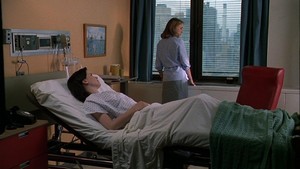
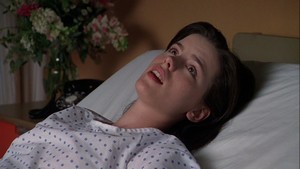
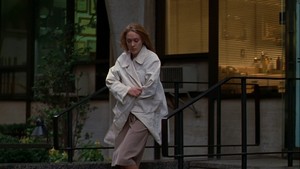
She sings “Amazing Grace/How sweet the sound/That saved a wretch like me/I once was lost, but now I'm found/ Was blind, but now I see” over a montage of Alice walking the city streets and then going into and coming out of an out-patient room in hospital (see Stillman, Last Days of Disco: a Novel, 280-84). Alice did get a sexually-transmitted disease, but that's no excuse for exposing her as it's no excuse to say you expose Miss Bates because she's irritating, inane and “has nothing” (in the novel's words) “to frighten anyone … into outward respect” (E 1:21):
Perhaps through music, filmic epistolarity (Naficy 5, 101-46) and chronotopes the appropriations bring out more dramatically than the heritage films underlying corrosive currents in Austen's writing; there is also an intensification as each film builds on and extends a previous. Over the course of the Austen filmic canon, from film to film, recur borrowed scenes of meditating or crying over boxes of letters, left by brother, father or lover: they begin in the 1983 Mansfield Park, then are found in the 1995 and 2007 Persuasions. Imitated from Davies's S&S where Morahan as Elinor gathers her letters:
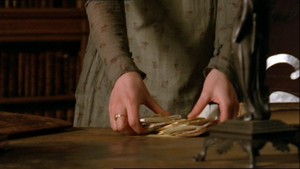
in the library as refuge, reads, then arches her body and head:
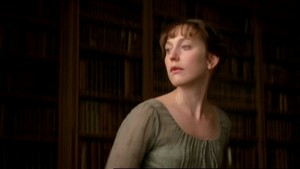
in From Prada to Nada, Nora sneaks out of bed late at night:
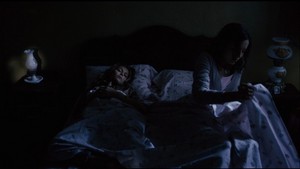
to focus on her packet of letters:
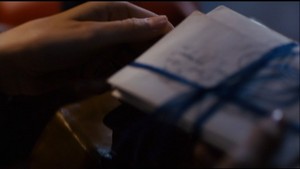
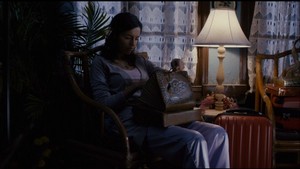
to his long-absent ignored illegitimate son (a transformed John Dashwood) . The Lee heritage S&S:
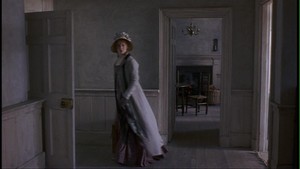
has Kate Winslet as Marianne pacing distractedly and powerfully in the alienating home. But in I Have Found It:

the 20th century Indian film can make Meenaski (our Marianne) a radio singer; in her song of radical distress, accompanied by visionary memories of dances and loss:
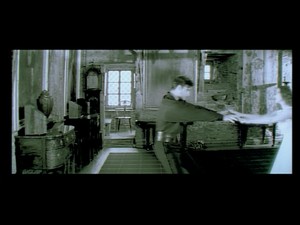
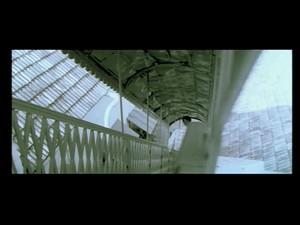
we hear haunting lyrics telling of stifled loneliness in the vast city: “In the evening:
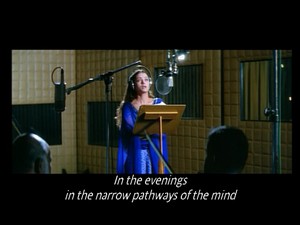
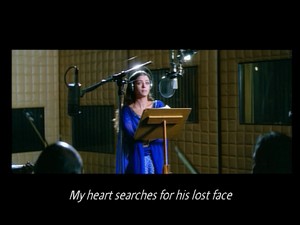
in the narrow pathways of my mind/My heart searches for a lost face/On the burning tar of city streets.”
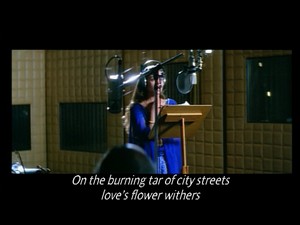
The character of Colonel Brandon as a melancholy ex-military man enables the 20th century Indian film-maker to appeal to male viewers who may have chosen or been coerced into military life, and then have to deal with trauma, crippling, and despair. In the opening of I have Found It, Colonel Bala (our Brandon) is an armed invader:

leaving his helicopter to cross a field on foot, he steps on land-mine:

crippled and when we first meet him depressive, alcoholic, he falls at a party, and is humiliated:
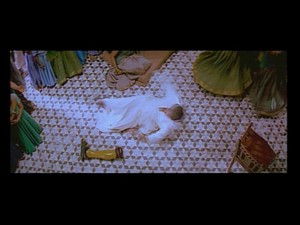
a zoom-shot accents this. There's nothing to stop heritage film-makers dramatizing Colonel Brandon's time in India, but the furthest anyone has gone so far has been to dramatize Brandon's duel with Willoughby so as to bring out the rage of resentment in the one:
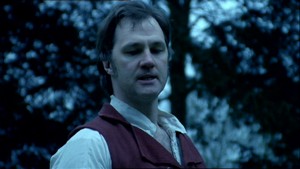
at the shameless indifference of the other:
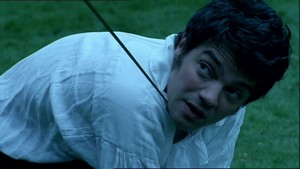
In post-colonial language Austen was an “economically-challenged” individual, her “dislocations” not “self-imposed” but based on “political” and “economic imperatives” imposed on her (Ghost and Sarker 103). The most powerful of the Austen films show us central characters rising to the challenge of a particularly painful order or cracking or nearly cracking under intense pressure. In S&S Austen gives us a dialogue within the self over how to cope with hard experience; in all her mature novels we see characters resist demands which would violate their innermost held convictions and needs, resolve to live self-dependently with loss and preserve what keeps life worth living. Those whose behavior Austen favors are rewarded with a seeming inward grace and the refuge of one another – with adequate funds: 2009 Emma:
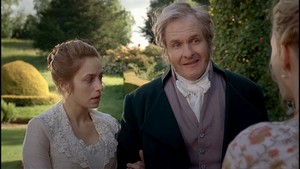
an as yet insecure “poor Miss Taylor” holding the arm of the kindly Mr Weston from the dramatized wedding day. Given the experience each film enables us to live through, it's understandable that this fantasy ending is continually credited as believable and intensely appealing.
1 It seems to me clear that the heritage film, out of Austen or other texts is alive and well and still producing sociological community events across countries, witness Downton Abbey for 3 years now, the continued top sales of the 1995 BBC/WBGH Pride and Prejudice and anniversary editions of the 1995 DVD of Ang Lee and Emma Thompson's Sense and Sensibility. I use their definition of an appropration; they focus on Rozema's 1999 Mansfield Park, the 2000 Tamil I Have Found It (a S&S film), and 3 Pride and Prejudice films: 2001 Bridget Jones, 2004 Bride and Prejudice and a 2003 Morman Pride and Prejudice set in Utah. I also follow Troost and others' use of the term heritage film in Cartmell and Whelenehan.
2 All the Austen novels fit today's transnational, accented and ambiguously disquieted heritage films Beyond what I've time in my paper to discuss Austen's character types, gender and class norms seem ideal for traditional cinemas: she has intelligent and mildly assertive chaste or virginal heroines who regard marriage and having children as their destiny; ethical heroes who debate what one should be ambitious for; and socially critical perspectives. Velayuthan 16-43, 76-94, Mishra 125-40; Naficy 3-15. Brubaker accounts for the proliferation of the term, “diaspora.”
3 Mrs Austen makes a comedy out of her disquiet over Jane's misfit: she can imagine what destiny probably awaits all her children but Jane:, see Tomalin on “Jane the Lord knows where” (143) . In these scenes Austen's characters remind me of those Henry James characters who are internal exiles
4 Hudelet says this Tamil film shows a society where all are “in search of an identity.” The characters we meet in the film are instances of a general transformation going on. For the male characters: Manohar-Edward defies his parents' demand he become an engineer in their factory and submit to an arranged marriage; Colonel Bala-Brandon, crippled from an exploding bomb in war overcomes alcoholic depression, to fulfill a role as mentor and then husband to Meenaski-Marianne; not everyone succeeds: Srika-Willoughby, a financier sees his business go bankrupt and turns to an arranged marriage for further financing.
- 1971 S&S BBC
- 1972 Emma BBC
- 1979 P&P BBC
- 1981 S&S BBC
- 1993 Ruby in Paradise Republic
- 1993 Bhaji on the Beach
- 1995 S&S Miramax
- 1995 Clueless Paramount
- 1996 Emma Miramax.
- 1996 Emma BBC/WBGH
- 1998 Last Days of Disco Westerly
- 2000 I Have Found It Sri Surya
- 2004 Bride and Prejudice Pathe
- 2008 S&S BBC/WBGH
- 2009 Emma BBC/WBGH
- 2010 From Prada to Nada Camelot/Odd
- 2010 Aisha Hindi
- 2010-13 Downton Abbey ITV
- Amin, Dina of Hamid Naficy, An Accented Cinema: Exilic and Diasporic Filmmaking, Princeton UP, 2001,” Journal of Arabic Literature 35:1 (2004):153-55.
- Austen, Jane. The Novels of Jane Austen. Ed. R. W. Chapman. 3rd ed. Oxford: OUP, 1933-69.
- ---------------. Jane Austen’s Letters. Ed. Deirdre Le Faye. 4th ed. Oxford: OUP, 2011.
- ---------------. The Manuscript Chapters of Persuasion, ed. R. W. Chapman. London: Athlone Pr, 1985
- Bailyn, Bernard. The Peopling of British North America. NY: Vintage, 1986.
- Brubaker, Roger. “The Diaspora Diaspora, Ethnic and Racial Studies, 28:1 (2005):1-19.
- Cartmell, Deborah and Imelda Whelehan, edd. The Cambridge Companion to Literature on the Screen. Cambridge UP, 2007. See especially Troost, “The nineteenth century novel on film: Jane Austen” and Eckart Voigets-Virchow, “Heritage and literature on screen; Heimlich and heritage 75-89, 123-37.
- Deleuze, Gilles. Cinema 1: the movement image, translated by Hugh Tomlinson and Barbara Habberjam. Minneapolis: Athlone Press, 1986.
- Goubert, Pierre. Jane Austen: Etude psychologique de la Romanciere. Presses Universitaires de Paris, 1975.
- Ghosh, Bishnupriya, and Bhaskar, Sarkar, “The cinema of displacement: Towards a Politically Motivated Poetics,” Film Criticism 20:1/2 (Fall 1995):102-13.
- Hodson, Christopher. The Arcadian Diaspora: An Eighteenth Century History. Oxford University Press, 2012
- Hudelet, Adrianne. “The construction of a myth: the 'cinematic Jane Austen' as a cross-cultural icon,” The Cinematic Austen: Essays on the Filmic Sensibility of the Novels, by David Monaghan, Adriane Hudleet and John Wiltshire. New Jersey: McFarland Press, 2009. 148-59.
- Mishra, vijay. Bollywood Cinema: Temples of Desire. London: Routledge, 2002.
- Naficy, Hamid. An Accented Cinema: Exilic and Diasporic Filmmaking. Princeton UP, 2001.
- Olson, Steve. Mapping Human History: Discovering Our Past Through Our Genes. Boston: Houghton Mifflin, 2002.
- Pateman, Carole. The Sexual Contract. Stanford: Stanford UP, 1988.
- Stillman, Whit. The Last Days of Disco, with Cocktails at Petrossian Afterwards. NY: Farrar, Strauss, & Giroux, 2000.
- Thompson, Emma. The Sense and Sensibility Screenplay and Diaries. NY: New Market, 1995.
- Troost, Linda and Sayre Greenfield, “Appropriating Austen: Localism on the Global Scene,” Persuasions On-Line, 28:2 (Spring 2008). http://www.jasna.org/persuasions/on-line/vol28no2/troost-greenfield.htm
- Woolf, Virginia. Three Guineas. 1938: reprint NY: Harvest/HJB, 1966
- Velayuthan, Selvraj, ed. Tamil Cinema: The cultural politics of India's other film industry. London: Routlede, 2008.
Home
Contact Ellen Moody.
Pagemaster: Jim Moody.
Page Last Updated 13 April 2013